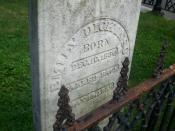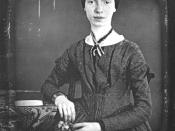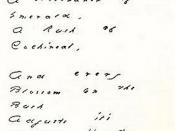Emily Dickinson wrote ÃÂThe Bustle in a HouseÃÂ in 1866. It is a ballad with two stanzas of four lines each, or two quatrains. There is no set rhyme scheme, because each of the lines is enjambled. The meter of the poem is trimeter, with every third line of each stanza being tetrameter.
The theme of The Bustle In the House is about how losing a loved one, while it is depressing in many ways, must not affect how we live our lives. Having to deal with many deaths herself, Emily Dickinson wrote this poem depicting the grievances she went through after losing her family members. The poem is written in a serious, yet calm tone, not despairing over the losses; the death was merely a ÃÂBustle in a HouseÃÂ. People would generally consider death to be the worst disaster that a loved one can endure, but Dickinson downplays death and reduces it to a ÃÂbustleÃÂ, a mere stir in a household.
DickinsonÃÂs word usage and capitalization are also subjects of criticism in this work. The capitalization of the word ÃÂMorningÃÂ shows that the word denotes something else. As previously stated, she physically demonstrates that man should not mourn over the loss with an absence of the word ÃÂmourningÃÂ and instead is replaced by ÃÂMorningÃÂ. ÃÂHouseÃÂ represents a place where life starts and where life ends. However, it is also a place that is unchanging and remains the same for eternity. Dickinson shows the importance of man moving on and how man should be like the house, where it continues to function in society. Society does not wait until man recovers from his loss, but rather carries on its tasks.
Dickinson also has heavy use of symbolism to show that man must accept deaths as they come and not...


